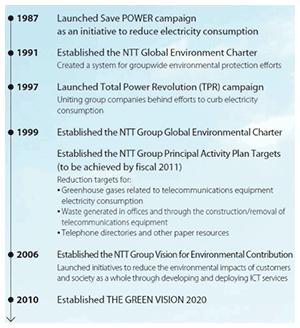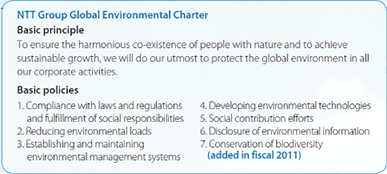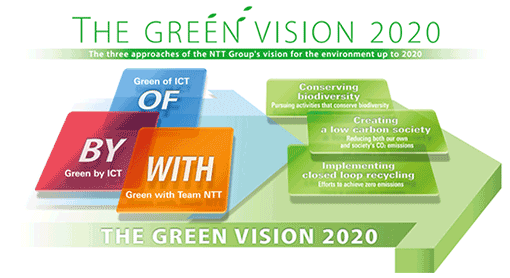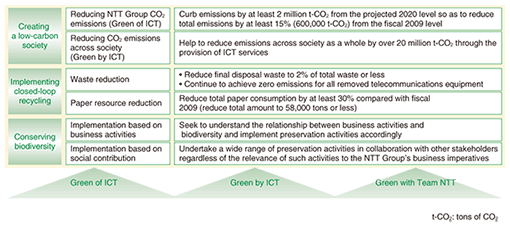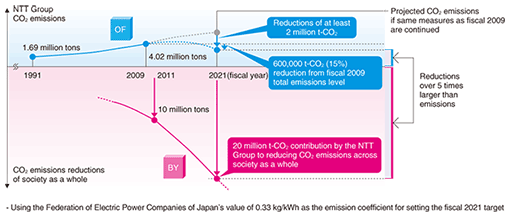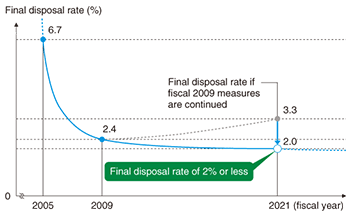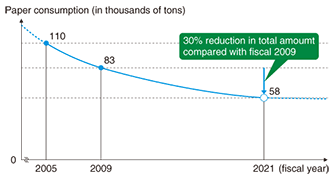 |
|||||
|
|
|||||
|
Feature Articles: New NTT Group Environmental Vision: Looking to 2020––THE GREEN VISION 2020 Vol. 9, No. 4, pp. 23–29, Apr. 2011. https://doi.org/10.53829/ntr201104fa3 New NTT Group Environmental Vision: Looking to 2020–– THE GREEN VISION 2020AbstractIn November 2010, the NTT Group formulated its new Environmental Vision, called THE GREEN VISION 2020. The Group identified three environmental themes: creating a low-carbon society, implementing closed-loop recycling, and conserving biodiversity. For each of these themes, we will drive those efforts through three approaches: Green of ICT, Green by ICT, and Green with Team NTT (ICT: information and communications technology).
1. IntroductionSince the beginning of the first commitment period of the Kyoto Protocol in 2008, there has been rapid worldwide growth of interest in environmental problems centering on global warming. In particular, in the quest for international agreements on the post-Kyoto protocol that is due to take effect from 2013, there was intense debate in the Fifteenth Session of the Conference of the Parties to the United Nations Framework Convention on Climate Change (COP15), held in Denmark in December 2009, and at COP16, held in Mexico in December 2010. In October 2010, the tenth meeting of the Conference of the Parties to the Convention on Biological Diversity (COP10) was held in Nagoya, Japan. This meeting aroused new interest in enterprise-level efforts to help conserve biological diversity. As global concern regarding global warming mitigation and biodiversity conservation intensifies, there are growing expectations that business enterprises should play key roles. The NTT Group recognizes that it is an important mission of the leading information and communications technology (ICT) service enterprise in Japan to formulate a new environmental vision that looks to 2020 and to publicly announce its commitment to environmental protection. 2. Environmental actions taken to dateIn 1991, the NTT Group formulated the NTT Global Environmental Charter, which aimed to ensure the entire Group’s organizational commitment to protection of the global environment (Fig. 1). This was followed by the Principal Activity Plan Targets, which spelled out three action plan targets for fiscal 2011: prevention of global warming, reductions in discharged waste, and reductions in paper consumption. In 2006, the Group looked at ways in which the use of ICT services can reduce the environmental impacts of both its customers and society as a whole and formulated the NTT Group Vision for Environmental Contribution, which defined the target of helping to reduce CO2 emissions by 10 million tons by fiscal 2011. In November 2010, with the achievement of all of these targets clearly in sight, the Group added the conservation of biodiversity to the basic principles of the NTT Global Environmental Charter (Fig. 2) and formulated a new vision called THE GREEN VISION 2020 (Fig. 3).
3. Concepts of THE GREEN VISION 2020The objective of THE GREEN VISION 2020 is to harness ICT and the collective strength of Group company employees to help encourage people to live in harmony with Planet Earth and thereby ensure the sustained development of society. Specifically, the Group identified three environmental themes that must be addressed well into the future: creating a low-carbon society, implementing closed-loop recycling, and conserving biodiversity. For each theme, the Group will make positive efforts through three approaches: Green of ICT, Green by ICT, and Green with Team NTT. These three environmental themes spell out what the NTT Group needs to focus on and sets specific targets. For example, in pursuit of a low-carbon society, we aim to reduce CO2 emissions from Group companies throughout Japan and also reduce CO2 emissions made by society at large through the provision of ICT services. Similarly, quantitative targets and specific action plans are defined for the creation of a recycling-oriented society and conservation of biodiversity. The Group will contribute to the sustained development of society through the achievement of these targets (Fig. 4).
The abovementioned action terms have the following meanings: Green of ICT means reducing the environmental impacts of the NTT Group’s business activities, Green by ICT means contributing to reductions in the environmental impact of society at large through the provision of ICT services; and Green with Team NTT refers to contributions to be made by NTT Group company employees and members of their families to a variety of environmental conservation activities in their homes and local communities as well as workplaces. 4. Creating a low-carbon societyWith a view to mitigating global warming, the NTT Group aims to help achieve a low-carbon society by reducing CO2 emissions generated by its regular business operations and by contributing to reductions in CO2 emissions produced by society at large by promoting widespread use of ICT services (Fig. 5).
4.1 Reducing NTT Group CO2 emissionsAs a consequence of the increase in power consumption resulting from the explosive growth in the use of the Internet and mobile phones since 1990, CO2 emissions from the NTT Group increased about 2.4-fold between fiscal 1991 and fiscal 2009. If we were to simply maintain our current energy-saving efforts, our predicted CO2 emissions would further increase owing to the greater power consumption involved in building the advanced broadband network infrastructures that will be required in order to expand the area served by the Next Generation Network (NGN), introduce the high-speed, high-capacity mobile broadband network called Long-Term Evolution (LTE), and increase the number of datacenters. To counter this trend, we will make stronger efforts to reduce power consumption through what we call the Total Power Revolution campaign, which involves the entire NTT Group. This campaign entails a broad spectrum of activities ranging from improving or upgrading telecommunications facilities, including air conditioning facilities, in order to reduce their energy consumption, to encouraging individual employees to save energy by, for example, dressing for work in ways that help minimize the need for air-conditioning and turning off unnecessary lighting. Furthermore, we will introduce highly energy-saving ICT facilities that conform to the NTT Group Energy Efficiency Guidelines, implement research and development (R&D) of energy-saving technologies, and promote the policy of Green NTT, which calls for increased use of natural energy with an emphasis on photovoltaic power generation. Through these efforts, we aim to reduce CO2 emissions by at least 2 million tons by fiscal 2021, which is a proposed 15% (0.6 million tons) decrease from the fiscal 2009 level. 4.2 Reducing CO2 emissions across societyThe use of ICT services is expected to contribute to reductions in CO2 emissions by society as a whole because it can potentially reduce the amount of physical movement of people and things, thereby improving the efficiency of energy usage. The NTT Group will contribute to a reduction in CO2 emissions across society by more than 20 million tons through its efforts to achieve smart communities. Such efforts include the provision of ICT services such as videoconferencing, teleworking, telemedicine, and electronic filing of applications and requests via the Internet; provision of services that help occupants to visualize energy use in homes and other buildings; and control of energy generation and energy storage devices. To calculate and publicize reductions in public CO2 emission levels, it is necessary to identify the amount of reduction achieved through the provision of specific services, and it is important to standardize the method of calculating CO2 emissions reductions so that the measurements can be used for international comparison. The NTT Group will work to achieve international standardization of such methodology. 5. Implementing closed-loop recyclingWith a view to helping to achieve effective use of non-renewable natural resources, the NTT Group is working to help create a recycling-oriented society by reducing the waste discharged and paper consumed in its regular business operations. 5.1 Waste reductionThe various types of waste generated by the NTT Group’s business operations can be broadly classified into construction waste generated when buildings are constructed or dismantled; telecommunications facility waste generated when telephone poles, switches, or telecommunication cables are dismantled; and office waste, such as glass and plastic bottles and cans. As of fiscal 2009, thanks to our long-established programs for reusing and recycling waste materials, we had reduced the proportion of waste subject to final disposal to 2.4%. However, because it is unlikely that our current activities will sustain this low proportion in light of an anticipated increase in the number of old buildings that need to be demolished, we will endeavor to achieve a sub-2% level of disposable waste by adopting design, operation, and disposal methodologies that are conducive to extending the lives of buildings, by reusing and recycling wherever possible, and by reinforcing intermediate treatment of waste materials, thereby eliminating the need to send any waste materials directly to final disposal sites. In particular, we will continue to target zero emissions (defined as final disposal proportion under 1%) in terms of telecommunications facility waste (Fig. 6).
In addition, we will contribute to reductions in the waste generated by society as a whole by promoting our business of reusing or recycling personal computers and by providing appropriate ICT services and solutions that will encourage paperless transactions. 5.2 Paper resource reductionThe NTT Group sends a substantial amount of paper to its customers in the form of telephone directories and bills. To help create a recycling-oriented society, it is important to reduce this paper consumption. We aim to make effective use of paper resources by closing the loop to create a recycling system whereby new telephone directories are produced using recycled paper from obsolete directories and by checking whether or not each customer wants a telephone directory when he or she moves or subscribes to a telephone service in order to eliminate unnecessary printing of telephone directories. We will reduce the need for paper bills by expanding our e-billing service whereby customers can view their bills online or receive details by email. We will also reduce the use of paper in offices by making the amount of paper consumed clearly visible, promoting paperless conferences, and using electronic booking systems. Through such measures, we aim to reduce paper consumption by more than 30% from fiscal 2009 levels (to below 58 thousand tons) as of fiscal 2021 (Fig. 7).
6. Conserving biodiversityTo help conserve biodiversity, the NTT Group will enhance and reinforce its existing activities on the basis of two new approaches formulated in accordance with the basic principles of the NTT Global Environmental Charter (Fig. 8).
In the approach based on business activities, the NTT Group will seek to better understand the relationships between its business activities and biodiversity and will continue to pursue those activities that are effective in helping to conserve biological diversity. Specifically, we will ascertain the impact made by the construction of telecommunications facilities on the ecosystem by carrying out assessments before construction starts and through ongoing monitoring after construction has been completed, and we will implement conservation activities accordingly. Paper for use in our business operations will be procured in an environmentally friendly manner, and we will continue to work on ways to minimize water usage. We will also strengthen conservation activities by making the most of our R&D results and technologies developed in the course of our business operations and our processes for transmitting relevant information to the public via the Internet. In the approach based on contributions to society, we will undertake a wide range of conservation activities regardless of their relevance to the NTT Group’s business imperatives. For example, we will collaborate with local communities and non-governmental organizations on the promotion of forest conservation activities, and we will contribute to the protection and nurturing of forests that play important roles in sustaining biological diversity. 7. Green with Team NTTIn addition to activities undertaken in the context of the NTT Group’s business operations, individual employees of the Group will seek to be eco-friendly in the office, at home, and in local communities in order to contribute to reductions in the environmental impacts of human activities. The Environmental Vision adds Green with Team NTT to the ongoing activities of Green of ICT and Green by ICT. Harnessing the powerful resource of the many people involved in or with the NTT Group, such as employees, family members, and retirees, we will undertake activities that help to preserve the environment and contribute to local communities. For example, our people will contribute to CO2 emissions reductions by saving energy at home, by practicing eco-friendly driving as learned through in-company training, and by participating in activities to clean up local environments under the Operation Clean Environment. 8. Future activitiesActivities in pursuit of THE GREEN VISION 2020 will get underway in fiscal 2012. To achieve this Vision, NTT Group companies and their employees need to make concerted efforts to reduce environmental impacts on an ongoing basis. Therefore, we will review the organizational structure for promoting environmental protection activities throughout the Group and ensure that the performance of these activities is well managed. Looking toward to fiscal 2021, we will contribute to the sustained development of a society in which humans live in harmony with the Earth by harnessing ICT and our human resources, which are the NTT Group’s strengths, in order to reduce the environmental impact of society as a whole. Reference
|
|||||








